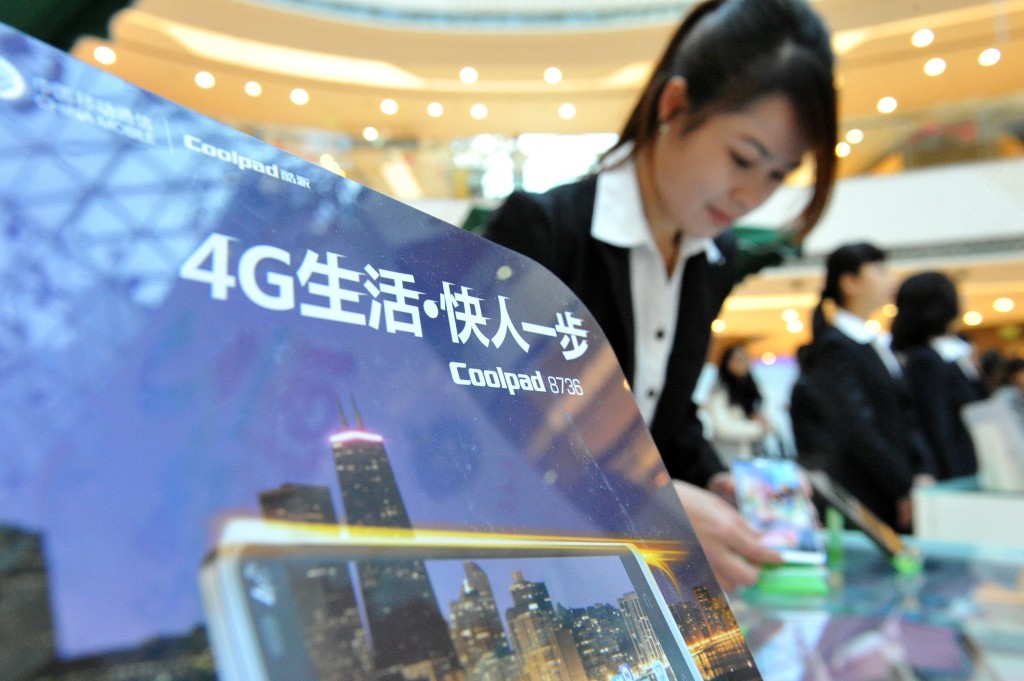 After two year’s speculation from industry and the public, the world’s largest communications market initiated the commercial deployment of 4G networks late last year. The Ministry of Industry and Information Technology (MIIT) issued fourth generation Time Division Long-Term Evaluation (4G TD-LTE or 4G) licenses to China Mobile, China Telecom and China Unicom on 4th December with an overall frequency resource allocation of 210 MHz. Dr Shen Jia of the China Academy of Telecommunication Research (CATR) says 2014 will see the construction of new networks with hundreds of thousands of base stations and the deployment of millions of 4G phones.
After two year’s speculation from industry and the public, the world’s largest communications market initiated the commercial deployment of 4G networks late last year. The Ministry of Industry and Information Technology (MIIT) issued fourth generation Time Division Long-Term Evaluation (4G TD-LTE or 4G) licenses to China Mobile, China Telecom and China Unicom on 4th December with an overall frequency resource allocation of 210 MHz. Dr Shen Jia of the China Academy of Telecommunication Research (CATR) says 2014 will see the construction of new networks with hundreds of thousands of base stations and the deployment of millions of 4G phones.
China’s ambitious ‘4G Plan’ will undoubtedly be a gold mine for the global mobile communications industry. However, companies attempting to seize the available opportunities should be prepared to be confronted by a series of challenges.
For the infrastructure vendors, the first ‘4G feast’ was carved up in China even before the licenses were released. In June, 2013, China’s largest carrier, China Mobile, launched the first-round, main network equipment tender bidding process for its TD-LTE network, which contained a purchase of 207,000 base stations. Several vendors, including Huawei, ZTE, Ericsson, Alcatel-Lucent and Nokia Solutions and Networks, shared the estimated RMB 20 billion (USD 3.27 billion) worth of contracts.
China Telecom and China Unicom are also planning to construct their LTE networks in 2014 although the investment scale will be smaller. Together, the three Chinese operators’ 4G bidding processes should return some growth optimism to network vendors over the coming years.
 What may disappoint the network manufacturing industry, however, is that the purchasing price of communications equipment continues to fall, which will cause vendors’ profits to shrink. Rivals during China Mobile’s bidding process posted only RMB 35,000 per carrier-sector on average. Although this was a substantial increase over the recent 3G purchasing price (about RMB 10,000), the price is only around 60 per cent of that in China Mobile’s first-round 3G bid (about RMB 60,000) in 2008.
What may disappoint the network manufacturing industry, however, is that the purchasing price of communications equipment continues to fall, which will cause vendors’ profits to shrink. Rivals during China Mobile’s bidding process posted only RMB 35,000 per carrier-sector on average. Although this was a substantial increase over the recent 3G purchasing price (about RMB 10,000), the price is only around 60 per cent of that in China Mobile’s first-round 3G bid (about RMB 60,000) in 2008.
Some analysts also reckon that, rather than putting in additional funding, carriers may merely redirect their original 3G investment to 4G. If this is the case, the emergence of the 4G market would not necessarily expand the aggregate market demand of telecom network equipment.
China’s 4G commercialisation plan will bring new marketing opportunities to leading terminal and chipset vendors. As a market leader in mobile device chipsets, Qualcomm is taking advantage of 4G’s introduction to shake off its pursuers. Benefiting from its mature 28nm (nanometre)-based semiconductor design, Qualcomm is able to integrate 4G, 3G and 2G modes into a single chip supporting over 10 frequency bands and operating with a low power consumption. This has allowed them to take a 90 per cent share of the LTE chipset market so far. In the terminal field, by tenaciously pushing out LTE products, Apple and Samsung have taken about 70 per cent share of the 4G handset market, thereby strengthening their dominant positions.
Furthermore, the highly-enhanced system capacity brought by 4G is integral to supporting a larger number of always-online terminals, which has encouraged the development of new types of mobile devices. Examples of this are wearable terminals like ‘smart glasses’ (e.g. Google Glass), ‘smart watches’ (e.g. SONY SmartWatch) and ‘smart clothing’, which allow a single user to use multiple mobile devices simultaneously.
Another example is ‘machine-to-machine’ (M2M) terminals which are used for communication between automatic sensors, rather than humans. With their emergence it is conceivable that the number of mobile devices may soon considerably exceed the human population. The limited capacity of 3G networks prevented operators in China from promoting the wide deployment of wearable and M2M terminals. Now this obstacle is expected to be eliminated with the support of 4G.
 A critical problem that chipset and terminal vendors face comes from increasing R&D and manufacturing costs. The tape-out (a semiconductor manufacturing process for chip production) cost for a chip has increased from USD 1 million for 3G (40nm) to USD 2-3 million for LTE (28nm). In order to accommodate additional 4G antennas, together with the legacy 3G, 2G and WLAN ones, within a slim and fashionable phone, vendors need to increase R&D resources to design a highly-integrated structure; meanwhile manufacturers cannot reasonably expect consumers to pay more for a 4G terminal to cover these increased costs.
A critical problem that chipset and terminal vendors face comes from increasing R&D and manufacturing costs. The tape-out (a semiconductor manufacturing process for chip production) cost for a chip has increased from USD 1 million for 3G (40nm) to USD 2-3 million for LTE (28nm). In order to accommodate additional 4G antennas, together with the legacy 3G, 2G and WLAN ones, within a slim and fashionable phone, vendors need to increase R&D resources to design a highly-integrated structure; meanwhile manufacturers cannot reasonably expect consumers to pay more for a 4G terminal to cover these increased costs.
It is predicted that the number of 4G subscribers in China may exceed 70 million in 2014. While 4G will provide users with a richer mobile broadband experience, it will also bring service providers more profitable opportunities. The increased speed of 4G networks will more effectively support video-sharing functions, leading to an increase in video-based, real-time APPs in smartphones such as video gaming, video shopping and video social-networking.
It will also encourage app providers to develop more attractive location-based services or so-called ‘augmented reality’ services. Coupled with 4G smart glasses, users will be able to enjoy real-time reviews of the local environment while walking down a street, such as interior views of nearby restaurants or available discounts in nearby shopping centres, and then book dinner reservations or reserve cinema tickets using their 4G phones.
Some analysts suggest that the introduction of 4G will actually aggravate price competition between carriers. Taking advantage of a lower cost-per-bit, pioneering LTE operators in the USA and Korea have attempted to increase market share by introducing more appealing 4G price plans, such as unlimited talk, unlimited text and a single pool of shareable data for multiple devices.
China Mobile’s 4G price plan, released last December, was regarded by Chinese users as a disappointing start. The plan, providing 600MB of data for RMB 50 seems too expensive compared to users’ expectations. Some may argue that this tariff implies that Chinese operators are intending to prevent a price drop when migrating from 3G to 4G. However, a substantial price reduction would be inevitable sooner or later before 4G becomes widespread in China.
A good development that 4G has brought China Mobile is that its cooperation with Apple is finally consolidated, after the fruitless, marathon negotiation during the 3G stage. The TD-LTE iPhones might help the largest operator by subscriber base to win back high-end subscribers from its competitors selling 3G iPhones.
Finally, it is worthwhile mentioning the risk to information security issues entailed by 4G development; it will lead to an inevitable increased significance that mobile terminals such as Smartphones play in our lives. They will be employed not merely for information exchange between people, but for various socio-economic behaviours, such as processing work affairs, paying bills and maintaining social contacts. Therefore securing information on mobile phones and avoiding its leakage from theft or hacking will become extremely challenging in the 4G era.
By 2013, 90 per cent of 4G users in the world (estimated at 120 million) were in the USA, Korea and Japan. In 2014, the hotspot for global 4G developments will shift to China. Similar to other emerging technologies, 4G will bring opportunities as well as challenges to industry and public alike. Only the companies or industries who keep adapting to developing trends will survive and grow in 4G era. We do not yet have a clear picture of where 4G will finally bring us. One thing is clear though: a single entity could never successfully overcome all the challenges and seize all the opportunities by itself, it will require interaction and cooperation across the whole ICT spectrum.
The China Academy of Telecom Research (CATR) is a telecommunications research organisation attached to the Ministry of Industry of Information Technology (MIIT) of China. For more than 50 years, the CATR has organised the standardisation and industrialisation activities for China’s telecom industry, and also supported the MIIT to form China’s telecom policy and regulations. Since 2004, the CATR has organised the LTE (4G) standardisation, test and trials in China before its commercialisation, and promoted the maturity of TD-LTE industry.
Dr Shen Jia has been working with the CATR since 2004. Now he is a director engineer focusing on research, standardisation and tests of 4G, 5G, M2M and other broadband wireless communications technologies. He received his BEng degree from Tsinghua University, Beijing in 2000 and his Ph.D. degree from University of York, England in 2005. Dr Shen is the first co-author of one of the best LTE tutorial books Long-Term Evolution: Technical Theory and System Design. He has three invention patents granted, and another six pending patents.


Recent Comments